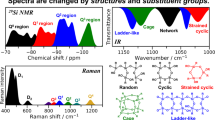Abstract
The thermal properties of 2,3-dimethyl-2,3-dinitrobutane (DMNB), a detection agent for explosives, have been determined by DSC measurements. Additionally, the results of an NMR study are compared with conclusions arrived at in the literature with regard to the source of two endotherms observed in the DSC. The thermal decomposition of DMNB is characterized by an exotherm with an energy in excess of 3 kJ g−1, observed in conjunction with a third endotherm resulting from the fusion of DMNB. Arrhenius parameters determined from both variable heating rate and isothermal measurements in the DSC are compared with predicted values assuming various mechanisms for the decomposition process.
Zusammenfassung
Mittels DSC-Messung wurden die thermischen Eigenschaften von 2,3-Dimethyl-2,3-Dinitrobutan (DMNB), einem Nachweismittel für Explosivstoffe ermittelt. In Ergänzung dazu wurden die Ergebnisse einer NMR-Untersuchung mit in der Literatur beschrie-benen Schlußfolgerungen bezüglich des Ursprunges von zwei in der DSC beobachteten Endothermen verglichen. Die thermische Zersetzung von DMNB ist durch eine Exotherme mit einer Überschußenergie von 3 kJ g−1 gekennzeichnet, die in Verbindung mit der dritten Endothermen beobachtet wurde, die vom Schmelzen des DMNB herrührt. Die im DSC sowohl über eine unterschiedliche Aufheizgeschwindigkeit als auch über isotherme Messungen bestimmten Arrhenius'schen Parameter wurden mit vorausgesagten Werten verglichen, wobei für den Zersetzungsprozeß verschiedene Mechanismen angenommen wurden.
Similar content being viewed by others
References
Doc. 9571 ICAO Convention, International Civil Aviation Organization, Montreal, Canada, March 1, 1991.
L. Elias, private communication.
T. Nishizaka, F. Katuragawa, K. Sawada, T. Oda and T. Koide, Chem. Express, 2 (1987) 257.
B.-G. Tan, L. H. L. Chia, H.-H. Huang, M.-H. Kuok and S.-H. Tang, J. Chem. Soc. Perkins Trans II, (1984) 1407.
K. Fritzsche, H.-D. Beckhaus and C. Rüchardt, Chimia, 42 (1988) 106.
L. F. Whiting, M. S. Labean and S. S. Eadie, Thermochim. Acta, 136 (1988) 231.
A. Pines, M. C. Gibby and J. S. Waugh, J. Chem. Phys., 59 (1973) 569.
N. G. Parsonage and L. A. K. Stavely, Disorder in Crystals, Clarendon Press, Oxford, 1978, p. 101.
B. T. Fedoroff and O. E. Sheffield, Encyclopedia of Explosives and Related Items, Vol. 5, Picatinny Arsenal, Dover, New Jersey, 1972, p. D1330.
R. N. Rogers, Thermochim. Acta, 3 (1972) 437.
J. B. Pedley, R. D. Naylor and S. P. Kirby, Thermochemical Data of Organic Compounds, 2nd Edition, Chapman and Hall Ltd., London, 1986, p. 188.
ASTM E 798-79 (Reapproved 1984), Arrhenius kinetic constants for thermally unstable materials, American Society for Testing Materials, Philadelphia, PA, USA.
R. Shaw, International J. Chem. Kinetics, 5 (1973) 261.
Author information
Authors and Affiliations
Rights and permissions
About this article
Cite this article
Jones, D.E.G., Augsten, R.A., Murnaghan, K.P. et al. Characterization of DMNB, a detection agent for explosives, by thermal analysis and solid state NMR. Journal of Thermal Analysis 44, 547–561 (1995). https://doi.org/10.1007/BF02636274
Received:
Revised:
Issue Date:
DOI: https://doi.org/10.1007/BF02636274




